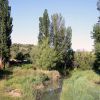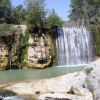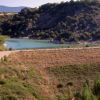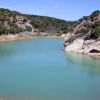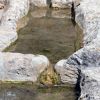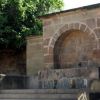Patrimonio Hidráulico
Waterfal or dam. Pozán de Vero

The irrigated land of Somontano has been maintained through a series of irrigation channels, dams and weirs since time immemorial.
Their origins can be traced back to Muslim times; in fact popular legend attributes this particular weir to the Moors. However, despite their remote origins, these constructions were continually renovated and modified over the years due to damage caused by the frequent flooding of the River Vero.
Azud (from Hispanic Arabic assúdd, itself derived from the classic Arabic sudd) is the name given to a dam built in a river with the aim of collecting water for irrigation and other uses. The Pozán dam is one of the best of its kind in terms of the quality of construction and its excellent condition.
It consists of a solid wall planted solidly on rock, which was built at a point of a huge natural pool in the river that was made deeper still by its construction. Maybe this pool was the origins of the village’s name as it was first mentioned as “Poz Sant” in 1095. (pozo is the Spanish name for a deep pool or well)
The aim of the dam was to raise the level of the water so that it could be directed to the San Marcos channel. From here it was used to move the wheels of several mills and a fulling mill as well as to irrigate the land around Castillazuelo and Barbastro.
In 1606 a lathe operator from Barbastro, Luis de Ruesta, and his son, were charged with the reconstruction of another dam close to here using oak. Wooden dams worked in a similar way as those made of stone as small rocks were placed between the struts. There were the most common type until the 16th- 17th centuries and although more fragile than those made entirely of stone, they were much cheaper to construct.
.
Moorish reservoir. Azlor
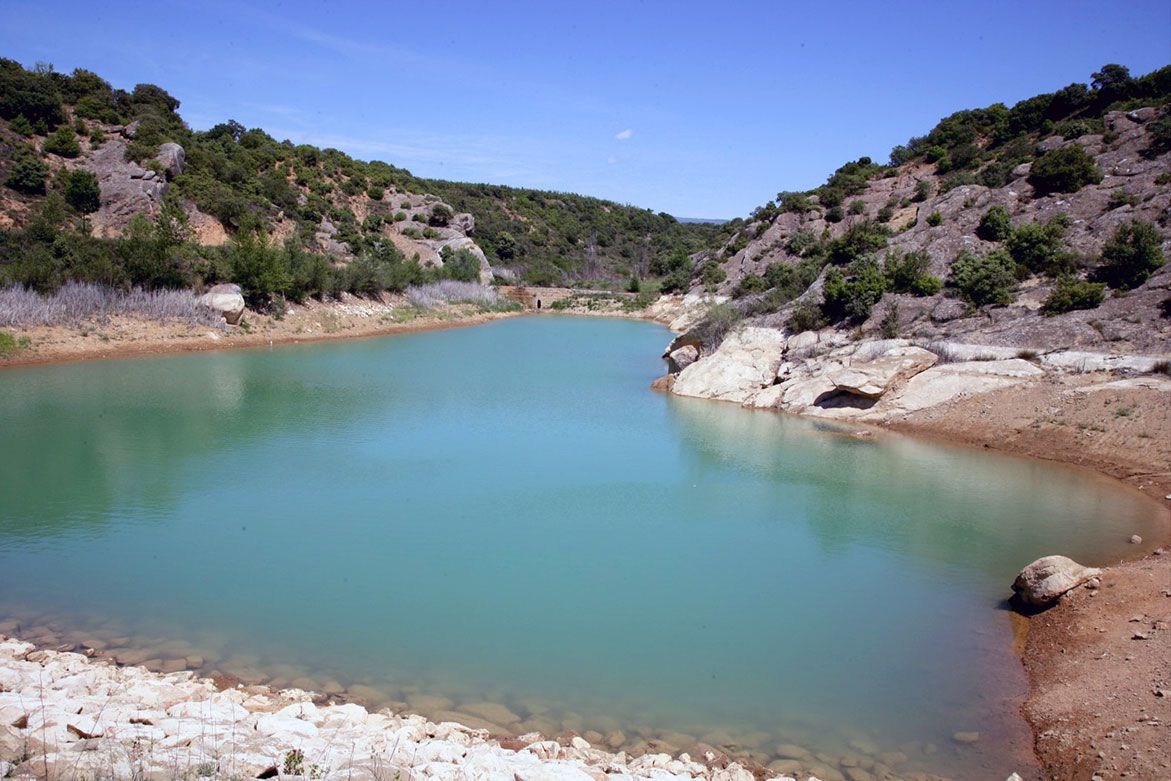
La Fondata reservoir was constructed at the end of the 18th century with the specific aim of storing water for irrigation. Although no major river runs through the Azlor municipality, a number of springs feed small streams and important canyons such as La Clamor.
Holding approximately 64 hm3 of water the reservoir was one of the largest in the whole country at the time of its construction at the end of the 18th century. Work began in 1795 and continued for at least five years. After recent renovation the reservoir is still in use today.
The water is held in the reservoir thanks to a curved wall (convex towards the exterior) that stretches for 50 metres to close the canyon. It is made of well cut, square ashlars of huge dimensions and creates a stretch of water of over 100 metres in length. The dam rises 14.95 metres from the ground and in the centre there is a small vaulted chamber that serves as a drain.
At the time of its construction, a work of this importance could only have been achieved in special circumstances. In this case, Azlor’s place as an estate of importance was assured due to its many economic resources.
In addition, a work of these characteristics could only be developed within a specific ideological context, that of “The Age of Enlightenment.” During this period, the whole of Spain was infused with a reformist spirit based on progress. The Court urged the most influential and wealthiest of people of each village to study the problems encountered with agriculture, livestock farming, industry, commerce and communication. In fact agriculture was at a peak, manufacturing was on the increase and commerce had intensified at this time so the moment was ideal and the reception of projects such as the Fondota Reservoir was enthusiastic.
La Fondota Reservoir is also known locally as the Moorish Reservoir referring to the clever use of water from an ancient past. In Somontano, popular tradition attributes many things that have uncertain origins to the Moors such as the Spring Well de los Moros en Ponzano, the d´os moros ice house in Buera and the Basacol pools in Alquézar...
Moorish fountain and washing area. Azlor

Across the whole of the region there are fountains based on the same design, which afford great character and personality to the Somontano heritage.
They are based on a model that was used throughout the 16th century. During this period the instigation of new techniques, an increase in skills of the master fountain makers and economic prosperity all made it possible to bring the precious liquid to villages.
This simple model was used until the beginning of the 19th century and is made up of a square body crowned with a simple moulding. An arch covers the spouts and the large tank below. This fountain is known as Labanera and stands out because of its size, the excellent quality of the ashlars and for the stone staircase, which gives an overall air of grandeur.The washing area is located next to the fountain. In contrast to other washing areas in the region that are almost always rectangular, these are unusual in that they have been excavated from sandstone rock. The water passed between different bowls designed for the various stages of washing clothes so that the cleaner water in the first could be used for rinsing. The different levels of the stones allowed people to doing their washing standing or on their knees.This washing area is known locally as the “Moorish Sinks” because in this region, anything that has uncertain origins is said to have belonged to “the time of the Moors.”
Some magical places of water such as these fountains and sinks are inhabited by beautiful women know as the “washerwomen.” They comb their long, golden hair with juniper oil by the light of the moon and soak their naked bodies and their dancing feet in the morning dew.
They are very elusive as so difficult to spot. Usually people only glimpse their white laundry hung up between the trees and spread over bushes. However, it is said that a person with a pure heart who is capable of seizing an item of their clothing will enjoy happiness, luck and great fortune for the rest of their lives. The clothes also have the power to undo witches spells.
These magical spirits related to nature and water are linked to ancient eras and Greek myths, such as the Naiads, nymphs that watched over fountains, wells and springs.
Villacantal Bridge. Alquézar
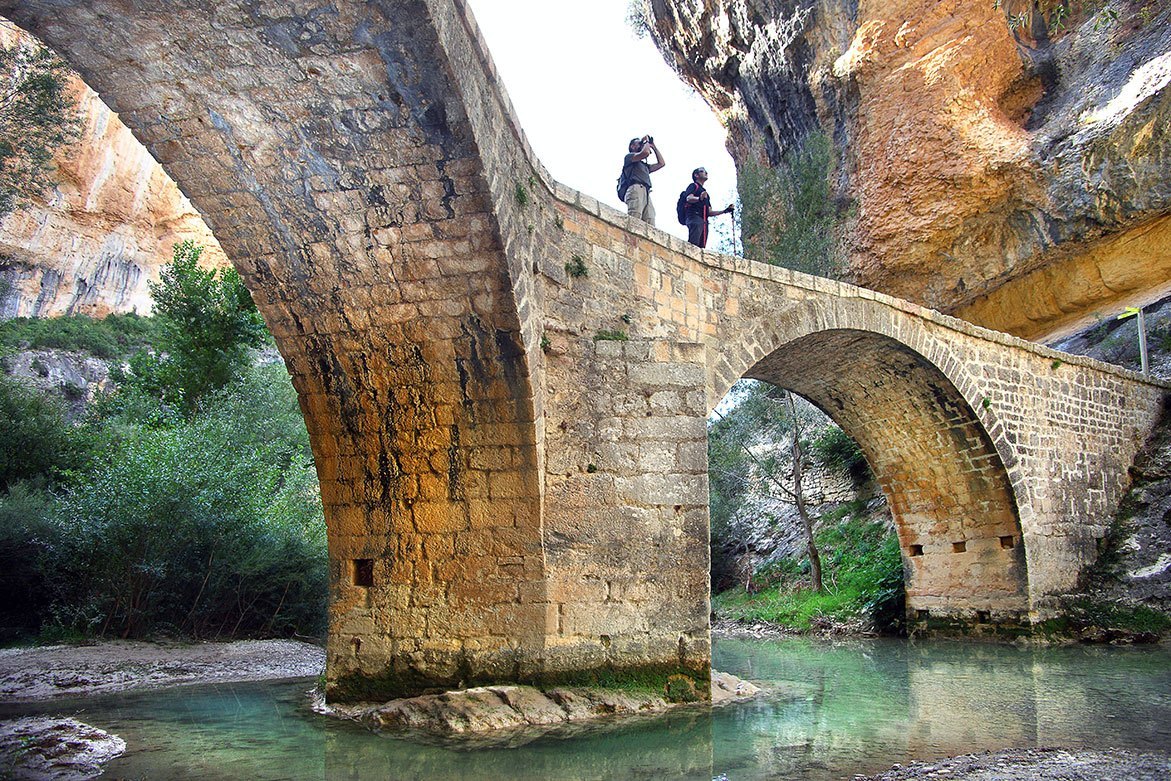
The bridge crosses the River Vero and unites the path from Sobrarbe with the road to Barbastro.
Its location at the end of the Vero canyon enhances the beauty of the environment, one of the most spectacular in Somontano.
Up close it is possible to contemplate the unnecessary width of the bridge deck, considering it joins narrow and steep paths that descend from the banks. The presence of a bridge in such a difficult to reach place highlights the importance of Alquézar as a hub of communication in the past.
The construction presents peculiarities that differentiate it from other bridges in Somontano including; an angled form; two spans - one semicircular and the other slightly pointed; a straight stretch of deck and another slightly inclined and an absence of a bordering wall.
Although folklore attributes its construction to the Romans, as is the case with many other bridges in the region, it is in fact a 16th century work.


